OLED TV vs. 4K LED TV; Which is better? 10-point Test
By Robert Wiley, Editor
For 2019 there may be a few OLED TVs left from LG on the market with less than 4K resolution. That will change shortly, with all new models containing 4K UHD resolution. LED backlit 4K UHD TVs (including Samsung's new QLED line) are technically really still LCD TVs with a higher resolution and are taking the name 4K UHD or 4K Ultra HD. 4K LCD TV is a more appropriate name. OLED TVs will always have OLED (whether 4K or 1080p) in the title due to the panel being self-lit by Organic Light Emitting DIodes and not using an LCD panel.
Update for 2018/2019: While Samsung and other manufacturers are sticking with 4K LED backlit Quantum Dot (QLED) TVs for 2019, LG continues to reap the reward of the premier picture quality technology in the market. The LED backlit TVs from other manufacturers have caught LG in features with the possible exception of WebOS still being the best Smart TV platform. Sony and Panasonic joined LG in producing OLED TVs in 2019, however they purchase the OLED panels from LG in order to do so, which means their models will be slightly more expensive than LGs. Sony's excellent processing technologies may make them worth extra money in some cases although LG is really putting forth the effort in processing capability in 2018/2019. While OLED TVs are still more expensive than good 4K LED TVs, the gap has narrowed. LG has 4 new OLED TV models and if there is one weakness to the technology aside from some motion artifacts, it's that there is a lack of size choices. 55 and 65 inch are the two dominant sizes that are reasonably priced. This will continue to be the case due to scale in production.
There are still challenges for Sony and Panasonic with production of OLED technology in terms of reliability and high costs. We believe this was also the case with Samsung though they did not specifically state this when we interviewed them. These reliability issues combined with higher costs of ramping up production has most manufacturers treading sand to improve 4K UHD technology by widening the color gamut and employing either Quantum Dot or a similar film technology (Nano-Crystal and QLED in Samsung's case) to enhance and solidify color.
OLED TV still has all the advantages listed in this article (including best overall picture quality) and since the 4K UHD resolution is now included in all OLED TVs, from a qualitative standpoint it will be very difficult for LED backlit 4K UHD TVs to compete with 4K OLED TVs. Samsung still has number one TV share and their marketing machine will shout out LED 4K benefits. However, professional reviewers (us included) will continue to point out that OLED is the better visual display technology. Sometimes the marketers win – just as they did with LED-LCD over Plasma technology. However, in terms of reliability and potential problems we will keep you updated by way of individual LG OLED TV and Sony OLED TV reviews as well as Samsung UHD TV Reviews. We have viewed OLED 4K side by side with LED 4K and everything else being equal (processing engine) we give a big nod to OLED 4K.
First let's delve into the technologies to find hints of which technology might win out. I certainly doubt there is room for two high price tag TV technologies.
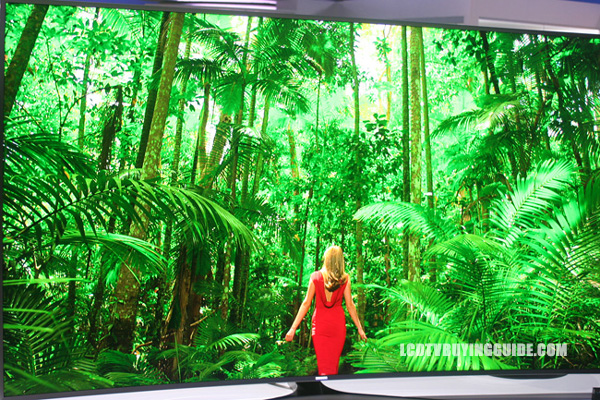
Samsung's curved UN65JS9500 SUHD

This shot shows off the amazing color and detail the Sony 4K UHD TV is capable of producing
Definitions:
OLED - Organic Light Emitting Diode
4K - (UHD or Ultra High Definition) defined as something around (3840 x 2160 pixel resolution) or 8,294,400 pixels or 4K progressive or 4 X HD resolution.
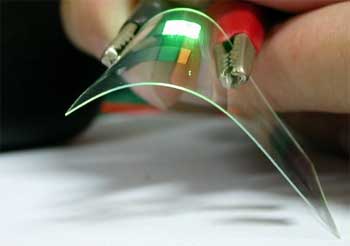
A lit organic light emitting diode cell
1) Color Rendition / Accuracy
Winner: OLED TV
While LED TVs have improved significantly over the years, I have always felt there is something lacking in the richness of color in LED backlit LCD Televisions. Colors do not have the depth that previous plasma TVs or now OLED TVs offer.

In OLED displays, each pixel contains red, green, and blue elements, which work in conjunction to create the millions of colors. Insofar as each pixel contains all the elements needed to produce every color in the spectrum, color information is more accurately reproduced with OLED technology than it is with LCD. We anticipate that the chromaticity coordinates will be more accurate with OLED than with 4K TV. From the OLED TVs that we have seen, color information is richer, deeper and more realistic than 4K TV (LCD TVs).
2) Sharpness Image Clarity
Winner: LED 4K TV
This is what the new 4K TV is all about. Incredible clarity. How well they do in this area depends upon how well these TVs up-convert a 1080p signal to 4K resolution – 4 times. This is very important due to the limited or virtually non-existent content available for 4K TVs in that native resolution. Some OEMs are better than others at this crucial element of processing and often offer their latest chip set (picture engine) as their advertisement for this important consideration. Sony is best in my opinion, while Samsung and LG are both good.
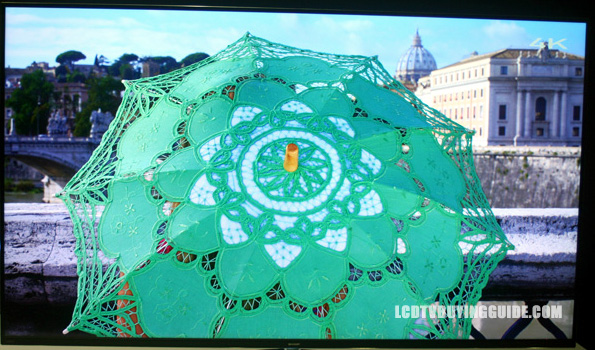
A shot of this Sharp 4K LED TV shows great detail and depth
One aspect I have noticed with OLED TVs both 4K and 1080p, is that there are often motion artifacts. It's not too distracting, but is reminiscent of early plasma TVs. Motion artifacts create a little blur sometimes around image edges. I believe OLED OEMs will get better at eliminating motion artifacts, but it will remain an issue.
3) Black Level/Contrast
Winner: OLED TV
OLED TV technology is more like plasma technology with individually lit pixel cells and therefore offers deeper blacks and unlimited gray scale. Blacks are inky and perfect in the new OLED TVs, while they will never be in LED TVs.
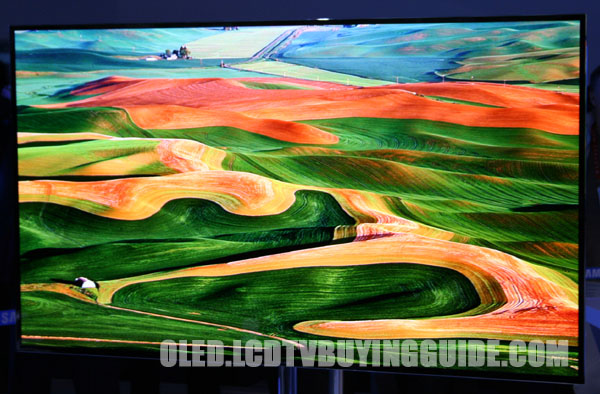
This is probably the best shot we've ever taken of a TV on the Samsung 55-inch OLED showing great dark shadow detail in the shaded areas, colors and light that pops, and exceptional contrast and detail
LED TVs by contrast are resolution enhanced but rely on the same LCD front panel (twisting crystals) with a backlight source (LED). While there have been incredible improvements in LED TV black levels, they will never match OLED TVs in this crucially important area.
There are two ways to increase contrast, by producing deeper darker blacks, or brighter whites. Producing darker richer blacks as OLEDs do, increases contrast in the best way and creates a deeper picture with colors that pop more. Brighter whites are primarily good for light room environments and HDR content.
4) Brightness/Peak White
Winner: LED 4K TV
The brightness and peak whites produced by LED TVs are unlimited because brighter LEDs can be produced in the future. OLED TVs by contrast are somewhat limited by the organic light emitting diode size of the pixel and organic structure of the material. There is no backlight in OLED TVs, but instead individual pixels.
Therefore if you need a super bright TV for daytime viewing for say a patio, an LED TV would be your best choice. I believe 4K will be hard to beat in this area with the constantly evolving LED technology.
5) Screen Uniformity
Winner: OLED TV
Screen uniformity is a drawback specifically related to LED backlight TVs (and CCFL). It really has to do with having backlights rather than lit pixels on the front of the panel. Edge Lit LED TVs (the new 4K TVs entering the market are edge lit or full array backlit) have even more problems with picture screen uniformity sometimes showing brighter background light at the edges of the screen or in bar formations across the screen. Turning the backlight setting down usually alleviates the problem.
OLED TVs by contrast have an extremely even spread of light across the picture due to each pixel cell being lit individually. It really enhances the beauty of the entire image.
6) Side Angle Viewing Quality
Winner: OLED TV
OLED TVs exhibit the same perfect side angle viewing as good plasma TVs do. This is also due to even lighting from each individually lit pixel. The lighting is close to the front of the screen panel than with LED backlit TVs.
LED 4K TVs with edge lit or even full array backlighting should be equivalent to the best LED TVs in side angle viewing quality. While they are getting better, they lag behind plasma and OLED.
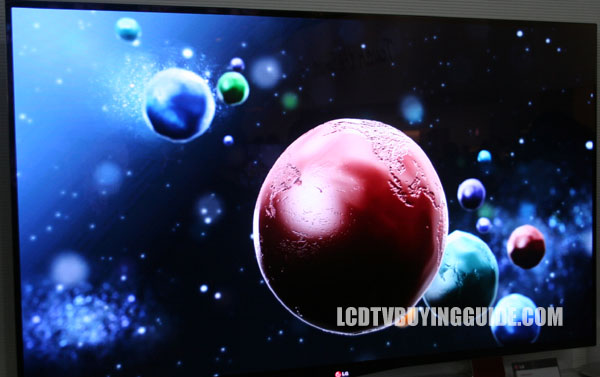
The LG 55EM9600 OLED TV boasts amazing black levels and color accuracy.
7) Overall Picture Quality
Winner: OLED 4K TV
OLED 4K TVs get my vote here because the categories they are best in are the most important for picture quality. Deepest blacks creates the best contrast, picture depth, and color that pops. Plus perfect side angle viewing quality. I can put up with a bit of motion artifacts and a picture that does not get as bright.
8) Longevity or Lifespan
Winner: LED 4K TV
OLED 4K TV technology is fairly untested, and therefore unknown. This gives rise to some concern – especially when remembering what happened with early Plasma TVs (then called gas plasma display technology). It was not pretty. Early plasma models developed burn in easily, and the green phosphors did not last long enough.
LED 4K TVs use long lasting LED backlights (edge lit or full array) and tried and true LCD front panels which are composed of twisting crystals. So this technology should last as long as 60,000 viewing hours; which when you break it down to 4 hours a day of viewing is 41 years. The LED bulbs will fade over time, however, and after many years the screen uniformity will get worse. And just in case your curious, the LED backlights cannot be economically replaced.
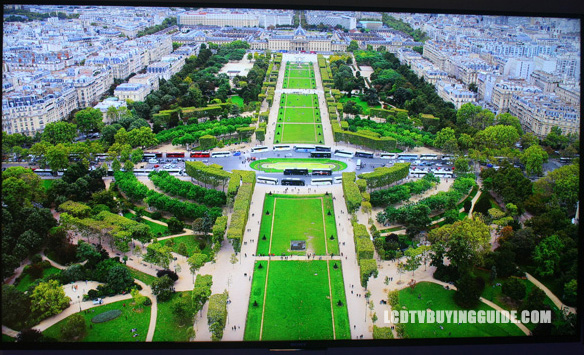
The Sony 4K TV displays bright colors and outstanding clarity
9) Price
Winner: LED 4K TV
OLED 4K TVs are still sold at premium prices and they vary a lot by size. The lowest price new LG 65” models are $3997 and are $1500 more than the 55” model. The previous year's models sold at a big discount. As of this writing I found one for $2488.
A top notch 8-Series Samsung LED 4K TV sells for under $2000. That's only one step below their top model for the year. It has most of their best picture technology and there is a lot of compensation built in for some of LCD/LED technology weaknesses.
10) Value and Overall Perfomance
Winner: Pick It
As a value oriented guy it's difficult to pay up for the significant increase in cost for today's OLED TVs. I was always a fan of plasma TVs over LCD/LED TVs though and if I could pay the same amount for either top quality OLED 4K TV or an LED 4K TV, there is no question I would choose the better picture quality of the OLED TV.
With today's price difference, I have to confess I would probably get a good LED 4K TV, or wait until the price differential narrows and get the OLED TV. A really good 55” LED 4K TV can be had for under $1000. That's very compelling.



